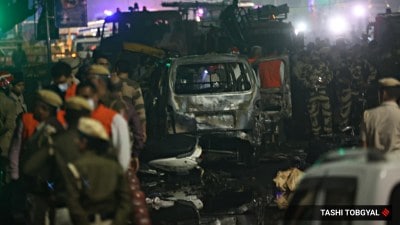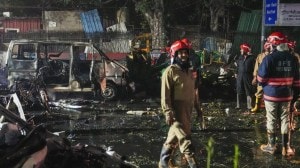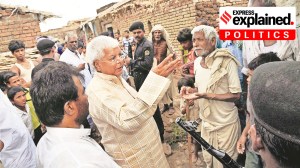Inside the maw of the beast
The United Nations is a deceptively and surprisingly small building. Once the "delegate" -- as the Foreign Minister or head of ...

The United Nations is a deceptively and surprisingly small building. Once the "delegate" — as the Foreign Minister or head of a national delegation is called — arrives, he or she is ushered in through a reception area. On one side journalists, photographers and television crews stand behind a counter. The "other side" heads off through a broad corridor. I have no idea where it goes.
Then it’s up by a few seconds on a small, narrow escalator (only one person can stand comfortably at a time), turn left, through a couple of large glass doors and voila! We are in the maw of the Beast — the United Nations General Assembly, a cavernous hall that soars over a hundred feet, dwarfing everyone within its portals. There is a wide corridor flanking the main hall and an area where visiting officials (as well as speakers) can sit on one side and non-government organisations on the other side.
Delegations are seated in alphabetical order: India is about halfway down the hall, in the middle block. In front of theIndian group is Germany and the country shares a desk with Indonesia (I’m sure none of our diplomats envied their situation: pilloried by the world and divided within for their role in East Timor. Behind India are Kuwait and Kiribati. Each side has three seats for the main delegates and three seats behind (in light-blue rexine and with earphones) for aides.
The national speakers deliver their homilies from a lectern; behind them sits the President of the U.N. General Assembly (a rather honorific title for someone who appears to be basically dealing with the roll call) and aides. The backdrop is a glowing brass sheen and above the delegations hang large, bluish spotlights; the overall impression of the hall is of blue and green, of little people scurrying around, talking with extreme seriousness into a little instrument that has come to symbolise the rush of modern life: the mobile phone.
This is the United Nations: here too you can’t do without the mobile, the ubiquitous little handie’, the universalsound that disturbs private conversations, meals at restaurants, walking on the street and even driving from Lajpat Nagar to Manhattan’s Lower East Side, from Guwahati to Goa. The tinny, jangling sound of the mobile invades the sanctity of the UNGA (the abbreviation for the General Assembly) as well as myriad conference halls that are available for meetings and discussions. People speak as animatedly or intimately into their little phones as they would at bilateral discussions or with lovers. No space is sacred any longer!
But the United Nations remains a significant institution not merely as a talking shop or a forum where nations let off steam at each other or express their viewpoints to the world but one which is a wonderful place for leaders from across the globe to meet and hold important bilateral and multilateral talks, often away from the glare of their national media.
It is especially important for small nations which do not have the budgets to establish and maintain diplomatic missions in toomany countries. It becomes, as Jaswant Singh, the External Affairs Minister pointed out to correspondents for the New York Times and the Washington Post, a centre for diplomacy, for conducting the business of international negotiations and meetings with top leaders of the world at minimal expense and maximum efficiency.
It’s like a smorgasbord: inside the building, just above the main entrance (there is a separate entry point for lesser mortals such as gawking tourists), the UN administration has set up small cubicles for bilateral discussions between ministers and delegates. So Jaswant Singh had a discussion with the Irish Foreign Minister at one of these "confession boxes" before moving on elsewhere.
Consider the efficiency of the system: instead of travelling all the way to Washington the Foreign Minister of Kiribati, for example, could call upon the US Secretary of State at the General Assembly, as well as on the leader of a fellow island nation.
There were discussions on non-alignmentand on the fate of island countries threatened by rising sea levels. One recalls the NAM movement very clearly because it was the day after Jaswant Singh had delivered his talk at the UNGA. There, Singh had spoken a couple of hours after Pakistani Foreign Minister Sartaj Aziz. The Pakistani, as we all know, went on to make an ass of himself by comparing Jammu and Kashmir with East Timor. Sometimes, you wonder if Pakistan’s establishment will ever grow up. Can’t they open their eyes, breathe or open their mouths without yelling Kashmir’? At the Non-Aligned meet, Singh was billed to speak for a few minutes. I had to slip out for a sip of water. On the way back, who should one see but Sartaj Aziz strolling outside the conference room? He didn’t technically stage a walkout because Singh was not speaking at the time. But he did leave the hall. The previous night, Pakistan’s Foreign Minister had gone out of his way to compare Kashmir and East Timor (to appeal for international intervention). Singh did not refer tothis in his talk but stuck to his written text. This riled the Pakistanis so much that they exercised the right to reply, which in diplomatic parlance meant that they could hurl some more abuse at India. Which they did, speaking of the "rotten core" of Indian nationalism. The US media did not report one word of these rantings.
It was, by comparison, India’s attitude of openness, responsibility and firmness that won New Delhi the support of the international community and prevented the emergence of Kashmir as a major question despite all of Islamabad’s efforts.
Yet, there are areas where India can and must do better. I, for one, had been unable to understand South Block’s reluctance to support former Bangladesh Foreign Secretary Farooq Sobhan in his bid to contest the post of Commonwealth Secretary General. There must be good reason for New Delhi’s position but Sobhan, it must be recalled — and I say this as a parochial Northeasterner — persuaded his government to put pressure on the NE insurgents in hiscountry, worked for a sub-regional dialogue involving Bangladesh, the Northeast and West Bengal and continues to take an interest in these issues as well as larger questions. The reason I mention this here is that Sobhan was at the United Nations lobbying for support. A country’s foreign policy must include good relations with its neighbours. One fails to see how a New Zealand nominee can understand the concerns of the developing world, especially our interests in South Asia. The backing of Sobhan will send a signal of our support not just to our neighbours but to smaller nations across the world.
In closing, a word about Jaswant Singh. During most of his luncheon and dinner meetings, because of his game shoulder, he scarcely got a chance to eat properly. But there was hardly a word of complaint. And as he returned to New Delhi from London the other morning, he came without the accompanying baggage so familiar to most ministers: no PAs, no hangers-on, no peon. He even carried his own hand luggage. Anexcellent example of unforced simplicity and openness for those in public life that might help redeem this community.





- 01
- 02
- 03
- 04
- 05


























